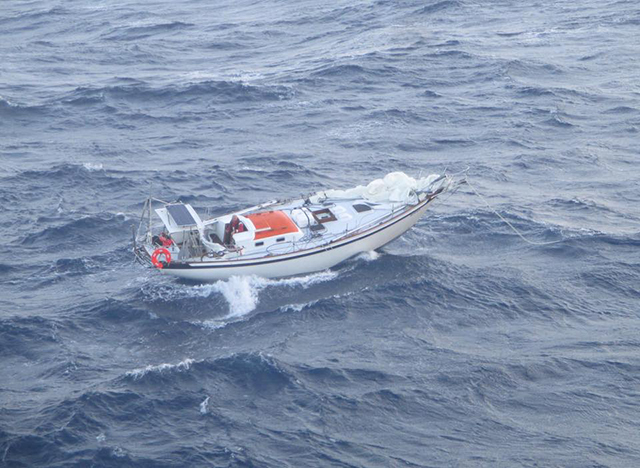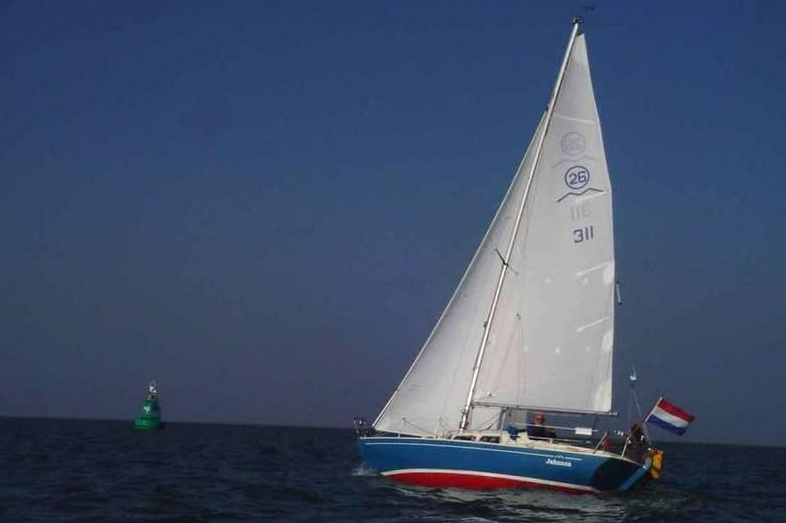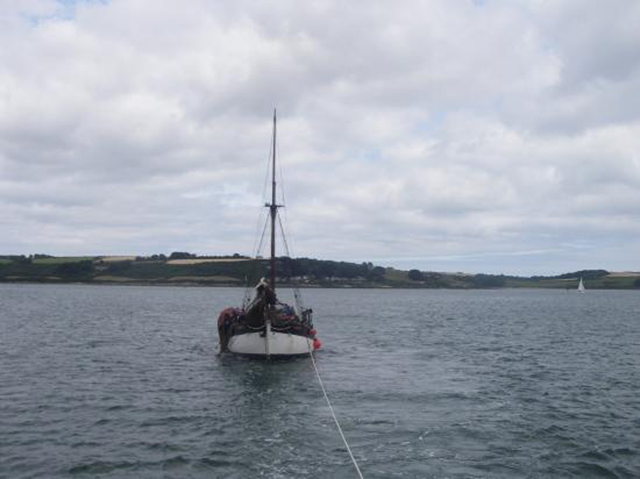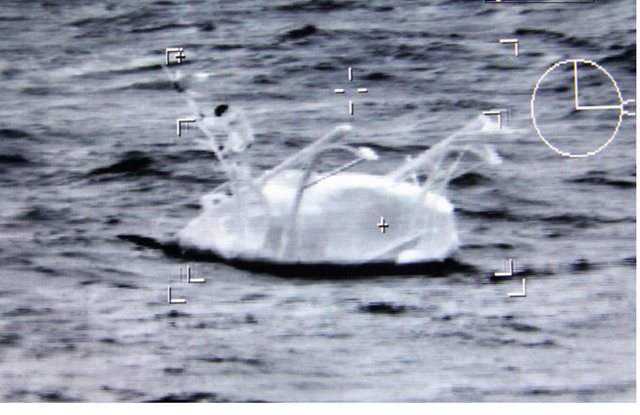New Zealander Conrad Colman wrote a new chapter in the storied history of the Vendée Globe when he crossed the finish line of the eighth edition of the non stop solo round the world race under a makeshift jury rig.
Colman took 16th place when he crossed the finish line at 1400hrs UTC today. The elapsed time is 110 days 1 hour 58 minutes and 41 seconds. He sailed 27,929 miles averaging 10.57 knots.
After being dismasted late on the evening of Friday 10th February, when he was in tenth place and some 250 miles west of Lisbon, Portugal, Colman constructed and stepped a remarkable jury rig which has allowed him to sail the final 740 miles of the 27,440 nautical miles race which started from Les Sables d’Olonne on November 6th 2016.
Since he was dismasted in what should have been his last big storm of his race, only three and half days from the finish line where he seemed assured of an impressive 10th place, Colman has run out of food and lasted out his final days on the survival rations from inside his life raft. On Wednesday he confirmed by radio that he had only two biscuits left.
Colman, a trained sailmaker and rigger, set one of the most efficient jury rigs seen in the history of ocean racing, working diligently and smartly to the end to improve the sheeting angles and hence efficiency of the rig which is constructed from his boom, part of his mainsail and his storm jib.
Only Philippe Poupon and Yves Parlier have previously completed the Vendée Globe under jury rig, while others, like Mike Golding and Loïck Peyron had to set up jury rigs to bring their boats back to shore.

Aerial image of Conrad Colman’s IMOCA yacht. Photo credit: Jean-Marie Liot/DPPI/Vendée Globe
Around the world with 0 emission
Colman achieves his goal of becoming the first ever skipper to race solo non stop around the world completing the Vendée Globe using no fossil fuels, only renewable energies, his electrical power generated by an innovative electric motor, solar and hydro generated electricity and stored in a bank of high tech batteries.
Before leaving Les Sables d’Olonne he explained: ‘The objective is to have it as a reflection of my philosophies. Growing up in New Zealand I was aware of the hole in the Ozone layer there. I converted to become a vegetarian not especially because I care about cute lambs but because I was more concerned about the global impact of the chain, of food production and consumption. And so the project is a reflection of my ideals.’
He also is first New Zealand born skipper to finish the epic solo round the world race, concluding a remarkable storybook adventure which has captivated race watchers from all around the world since long before the start. His finish reflects his incredible tenacity, drive and talent, the culmination of a dream which saw him move from the USA to France over 10 years ago to pursue his goal of competing in the legendary solo round the world race.
From pursuing an academic and business career in the USA, where his late father was from, Colman worked different marine related jobs to expand his skillset to a level where he could achieve a competitive finish in the Vendée Globe. Before the start he spoke of how he had staked his financial future in taking part in the race.
He found an unloved IMOCA 60 designed by South African Angelo Lavranos which to date had a chequered, limited racing history where he lived in Lorient, where it was being used for day charter hires, and set about refitting and re-optimising the boat in order that he could realise the boat’s true, untapped potential.
Even a matter of 10 days before the race start Colman did not have the funds to compete at what he considered to be the very minimum level of participation. But he was determined to go anyway. An absolute last minute call found support from the London based Foresight Group. His boat was only branded two days before the Sunday 6 November start.

Conrad Colman, skipper Foresight Natural Energy, at start of the Vendee Globe. Photo: Jean-Marie Liot/DPPI/Vendee
On start day he said: ‘I feel great. How could I not. It is the start of the Vendée Globe and it is a sunny day. It is a dream I have been chasing for years and years and I have it here in my grasp. It was hard to say goodbye to my wife. I hang my wedding ring in the cockpit so she is always with me.’
His spirit and skills have been tested in equal measure and on many occasions he has overturned situations which would have ended the Vendée Globe of lesser sailors.
Even just days into his race he found an innovative way to repair a keel ram problem which jeopardised his race. An electrical fire damaged the wiring on his Foresight Natural Energy which sent his autopilots haywire. In one incredible 12 hour period he climbed his mast three times, spending hours aloft to repair sails.
The 33 year old has made mast climbing an almost commonplace skill among his extensive personal armoury of abilities required to compete in the Vendée Globe, despite the fact it was a fall from the top of a mast which took the life of his father whose legacy Colman holds dear.
In the middle of the Pacific Ocean, near to the most remote point on the race course, Colman was caught in the path of one of the biggest storms of this race. His forestay, which holds up the mast, became detached when a pin failed. His IMOCA was knocked flat and stayed over for some hours in huge seas and winds gusting to 40-45kts. He took four days to recover, replacing the forestay, finally losing touch with Nandor Fa, the Hungarian skipper with whom he raced the 2014-2015 on Fa’s Spirit of Hungary who went on to take eighth place.
Colman said: The VG is more than ever I could have imagined. The conclusion of a voyage that has lasted ten years. So much harder than I had imagined. An incredible opportunity to find the energy within to fight. To face all these challenges that were thrown my way.
‘It’s a solo race, but this is a team effort. I relied upon all the people here who supported me. That enabled me to cross the finish. This moment is indescribable. If I tried to put it into words, I would burst into tears. I can’t believe all these people were here for me.
‘Over the past 10 years, I have lost sleep. I didn’t think I would ever make it to the start line. But through hard work and good luck this journey became a reality for me. I’m so eager to share it with everybody that came here today and all those who face a challenge in their own lives. Anything is possible, but you need a team around you. Every single day I had to fight. The jury rig is just a manifestation of what I had to do every day.’
He added: ‘For a moment, I didn’t think it as going to be possible, when the mast came down. I called the Race Directors, but I didn’t want to ask for assistance. I managed top put one foot in front of another, as I did throughout this race. The person who set out at the start would not have been able to do that.
‘I had to find the strength within myself each time. I have changed. That is the case for everyone. I feel nothing can beat me. We’ll be back in four years with my own boat. I’m proud of everything. I’m not ashamed of the dismasting.’
Thomson claims second in historic Vendée Globe race
British yachtsman Alex Thomson has taken the runner-up spot in the Vendée Globe to become the solo round-the-world race's second-fastest…
Golden Globe entrant Shane Freeman rescued from dismasted yacht
Australian yachtsman Shane Freeman has been rescued by a Chinese-flagged grain ship after his yacht Mushka was knocked down and…
French Navy helicopter captures stunning Vendée Globe shots
A French Navy helicopter captured some stunning Vendée Globe race footage of British yachtsman Alex Thomson and his closest rival…
‘Swings and roundabouts’ for the Vendée Globe race leaders
'It's brutal. Absolutely brutal. I do wonder why I do this sometimes", says Britain's Vendée Globe contender Alex Thomson
Sailor refuses to abandon yacht
Boat dismasted and low on fuel
Solo sailor rescued after drifting for 11 weeks
Missing since January dismasting in the Indian Ocean
Dismasted 100-year-old boat rescued
The historic vessel's wooden mast broke, sending the rigging and sails overboard
Man rescued from dismasted trimaran in Channel
An air and sea search got underway after a VHF radio Mayday call was heard
Dismasted Sigma 38 sails 530 miles for a new mast
A dismasted yacht has been successfully sailed from northern Spain to Cowes, Isle of Wight under jury rig - for…












